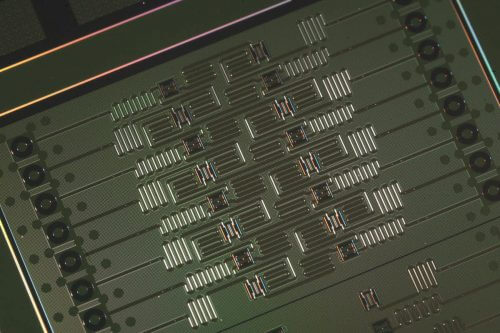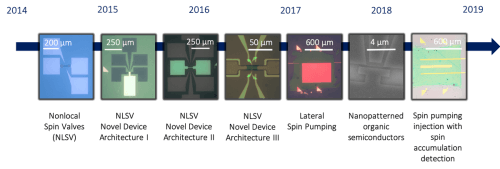Organic molecules have opened up a new and interesting possibility for the development of an efficient and stable quantum computer. On the one hand, carbon molecules are more stable and allow calculation in a larger amount of qubits, on the other hand, the fine control of molecules is still in its infancy

The second quantum revolution is already underway. Computers based on quantum properties will revolutionize the world in a variety of fields. The era of general quantum computers (superior in calculation efficiency and adaptive to programming) will solve complex problems that no supercomputer today is capable of calculating in a reasonable time. Transistor-based computers (home computers) encode the information in their possession using the binary method. Each piece of information ("bit") is translated into a unique chain consisting of the digits 1 and 0. The digital information is actually the current flowing through the transistors that make up the processor - when the current passes through the transistor we call the bit a 1 and when there is no current it represents the number 0.
In 1997, theorists Daniel Los and David DiVincenzo presented for the first time the basic conditions for creating a quantum computer. Compared to classical computers, the most basic piece of information in a quantum computer is called a "qubit" which actually consists of a single particle. A particle has a quantum property called spin and in simple words it describes the direction in which the particle rotates around itself, just like the Earth rotates around itself relative to a defined axis. The digital value from each particle is translated relative to which axis the particle rotates. If the axis is directed towards the "north pole" of the particle we will call the spin value as 1 and in relation to the "south pole" as 0. If the particle is kept under the right conditions, it can "rotate" around both axes at the same time, thus utilizing the space of possibilities at the same time. When the particle is isolated from the environment, it can be found in any axis on the surface of the spherical shell, and if it is not fully present towards one of the poles, we call the situation a superposition, that is, the particle rotates a little around the south pole and a little around the north pole, it is a certain percentage in the 0 position and a complementary percentage in the 1 . When hundreds of particles are placed in this position intertwined with each other, that is, the spin values of the particles are related to each other, a piece of information is created that can effectively be found in the entire space of possibilities at the same time. The strange feature makes it possible to create a kind of fast and efficient parallel calculation.
Besides the spinor basis that DiVincenzo proposed, he drew the attention of the scientific community to four other conditions for the existence of quantum computers, including the lifetime of the stored information, how sensitive the system is to manipulations, and how high-quality the reading of the information from the complex physical systems is. Today, DiVancenzo's model is the leading model and there are several applications that utilize the spin property of the electrons for the benefit of calculation - through an ion trap, superconductors, and the use of holes in the crystalline structure of the diamond. Unfortunately, the physical conditions needed for such systems are very extreme - an almost perfect vacuum, temperatures close to absolute zero and isolation from the environment. Along with the challenging conditions, the systems are difficult to control as the number of spins (qubits) increases.

Molecular spintronics
Electronics based on the spin of the electron and not on its electric charge is called "spintronics". The magnitude of the spin can be measured and controlled using external magnetic fields. The main use of spintronics appears mainly in hard memories in home computers and USB flash drives. Recently, researchers have discovered that spintronics can be used with the help of chains of carbon molecules and may in the future use them as a basis for quantum computing. It turns out that it is relatively easy to attach the carbon molecules at small intervals and even with their help to reduce the amount of noise compared to other conductive materials that are made of qubits. Thanks to the noise reduction, the carbon molecules can be used for longer and more stable calculations. Alongside the impressive promises, there are a number of open problems that have not yet been answered, such as what is the mechanism that extends the quantum stability of systems based on organic molecules such as carbon? How can you use them to build electrical circuits for calculation? And even if we overcome these problems, we will have to know how to measure the spin of a single molecule and influence it accurately without harming its environment. In addition, apart from the noise resulting from spin interaction, the electrical noise resulting from a weak current movement is added following the hopping of electrons between the carbon molecules. There is still a lot of work, but it seems that the field of spin molecules is accelerating, expanding horizons and opening up new possibilities for quantum technologies.
The article is based on the article next By physicist Deepak Venkateshvaran
More of the topic in Hayadan:

2 תגובות
Hello Gadi,
In any text that explains a scientific phenomenon, we are required to make some kind of simplification. Every phenomenon hides many ideas within it, the question is to what level of precision you are required in the explanations. Sometimes we need the simple explanations to convey the main message. There is no reason for us to use Einstein's laws of gravity and the curvature of space-time to explain why the apple falls to the ground. This is despite the fact that Newton's laws lack deep and important ideas about how gravity behaves. Likewise, there is no reason to state that spin is a particle property that responds to a magnetic field. The analog to rotation really comes from the electromagnetic force. When an electron, for example, moves in a circular motion (in a circular path that does not revolve around itself), the magnetic field can change its plane of rotation, or in other words, the direction of rotation. In the same way, there is an intrinsic property for elementary particles that if they find themselves in an environment with a magnetic field, they will react in the same way and change the value of the spin as if it indicated the direction of the self-rotation of the particle. It is true that the particle does not actually rotate on its own, but the response to the magnetic field is the same as the classical analogue. This is an overly technical element that is not always necessary to convey the message. If you were missing this information, you can always ask nicely. All the best and keep curious
"A particle has a quantum property called spin and in simple words it describes the direction in which the particle rotates around itself"
you confused me! In every explanation about the atomic dose, when you get to SPIN, you bother to mention that it is not about the rotation of the atom or the direction in which the electrons rotate around it.
For example, from the website of the Davidson Institute (belonging to the Weizmann Institute)"
"First of all, you are right that the spin is not a "real spin" as you called it, and is not related to the rotation of the particle around itself."
https://davidson.weizmann.ac.il/online/askexpert/physics/%D7%9E%D7%94%D7%95-%D7%94%D7%A1%D7%A4%D7%99%D7%9F-%D7%A9%D7%9C-%D7%94%D7%90%D7%9C%D7%A7%D7%98%D7%A8%D7%95%D7%9F-%D7%AA%D7%95%D7%9D